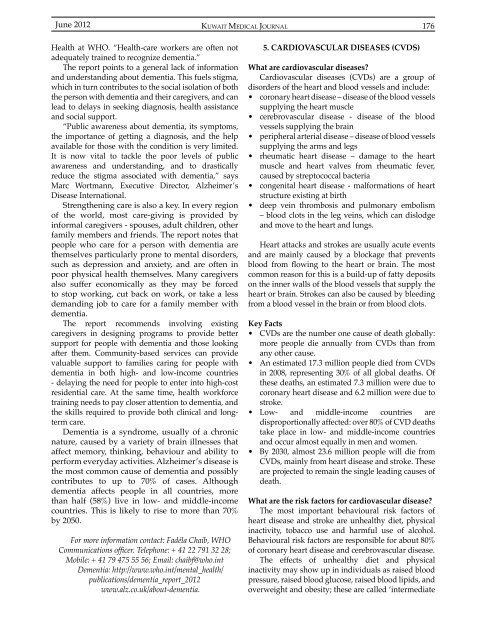Vol 44 # 2 June 2012 - Kma.org.kw
Vol 44 # 2 June 2012 - Kma.org.kw
Vol 44 # 2 June 2012 - Kma.org.kw
Create successful ePaper yourself
Turn your PDF publications into a flip-book with our unique Google optimized e-Paper software.
<strong>June</strong> <strong>2012</strong><br />
KUWAIT MEDICAL JOURNAL 176<br />
Health at WHO. “Health-care workers are often not<br />
adequately trained to recognize dementia.”<br />
The report points to a general lack of information<br />
and understanding about dementia. This fuels stigma,<br />
which in turn contributes to the social isolation of both<br />
the person with dementia and their caregivers, and can<br />
lead to delays in seeking diagnosis, health assistance<br />
and social support.<br />
“Public awareness about dementia, its symptoms,<br />
the importance of getting a diagnosis, and the help<br />
available for those with the condition is very limited.<br />
It is now vital to tackle the poor levels of public<br />
awareness and understanding, and to drastically<br />
reduce the stigma associated with dementia,” says<br />
Marc Wortmann, Executive Director, Alzheimer’s<br />
Disease International.<br />
Strengthening care is also a key. In every region<br />
of the world, most care-giving is provided by<br />
informal caregivers - spouses, adult children, other<br />
family members and friends. The report notes that<br />
people who care for a person with dementia are<br />
themselves particularly prone to mental disorders,<br />
such as depression and anxiety, and are often in<br />
poor physical health themselves. Many caregivers<br />
also suffer economically as they may be forced<br />
to stop working, cut back on work, or take a less<br />
demanding job to care for a family member with<br />
dementia.<br />
The report recommends involving existing<br />
caregivers in designing programs to provide better<br />
support for people with dementia and those looking<br />
after them. Community-based services can provide<br />
valuable support to families caring for people with<br />
dementia in both high- and low-income countries<br />
- delaying the need for people to enter into high-cost<br />
residential care. At the same time, health workforce<br />
training needs to pay closer attention to dementia, and<br />
the skills required to provide both clinical and longterm<br />
care.<br />
Dementia is a syndrome, usually of a chronic<br />
nature, caused by a variety of brain illnesses that<br />
affect memory, thinking, behaviour and ability to<br />
perform everyday activities. Alzheimer’s disease is<br />
the most common cause of dementia and possibly<br />
contributes to up to 70% of cases. Although<br />
dementia affects people in all countries, more<br />
than half (58%) live in low- and middle-income<br />
countries. This is likely to rise to more than 70%<br />
by 2050.<br />
For more information contact: Fadéla Chaib, WHO<br />
Communications officer. Telephone: + 41 22 791 32 28;<br />
Mobile: + 41 79 475 55 56; Email: chaibf@who.int<br />
Dementia: http://www.who.int/mental_health/<br />
publications/dementia_report_<strong>2012</strong><br />
www.alz.co.uk/about-dementia.<br />
5. CARDIOVASCULAR DISEASES (CVDS)<br />
What are cardiovascular diseases?<br />
Cardiovascular diseases (CVDs) are a group of<br />
disorders of the heart and blood vessels and include:<br />
• coronary heart disease – disease of the blood vessels<br />
supplying the heart muscle<br />
• cerebrovascular disease - disease of the blood<br />
vessels supplying the brain<br />
• peripheral arterial disease – disease of blood vessels<br />
supplying the arms and legs<br />
• rheumatic heart disease – damage to the heart<br />
muscle and heart valves from rheumatic fever,<br />
caused by streptococcal bacteria<br />
• congenital heart disease - malformations of heart<br />
structure existing at birth<br />
• deep vein thrombosis and pulmonary embolism<br />
– blood clots in the leg veins, which can dislodge<br />
and move to the heart and lungs.<br />
Heart attacks and strokes are usually acute events<br />
and are mainly caused by a blockage that prevents<br />
blood from flowing to the heart or brain. The most<br />
common reason for this is a build-up of fatty deposits<br />
on the inner walls of the blood vessels that supply the<br />
heart or brain. Strokes can also be caused by bleeding<br />
from a blood vessel in the brain or from blood clots.<br />
Key Facts<br />
• CVDs are the number one cause of death globally:<br />
more people die annually from CVDs than from<br />
any other cause.<br />
• An estimated 17.3 million people died from CVDs<br />
in 2008, representing 30% of all global deaths. Of<br />
these deaths, an estimated 7.3 million were due to<br />
coronary heart disease and 6.2 million were due to<br />
stroke.<br />
• Low- and middle-income countries are<br />
disproportionally affected: over 80% of CVD deaths<br />
take place in low- and middle-income countries<br />
and occur almost equally in men and women.<br />
• By 2030, almost 23.6 million people will die from<br />
CVDs, mainly from heart disease and stroke. These<br />
are projected to remain the single leading causes of<br />
death.<br />
What are the risk factors for cardiovascular disease?<br />
The most important behavioural risk factors of<br />
heart disease and stroke are unhealthy diet, physical<br />
inactivity, tobacco use and harmful use of alcohol.<br />
Behavioural risk factors are responsible for about 80%<br />
of coronary heart disease and cerebrovascular disease.<br />
The effects of unhealthy diet and physical<br />
inactivity may show up in individuals as raised blood<br />
pressure, raised blood glucose, raised blood lipids, and<br />
overweight and obesity; these are called ‘intermediate
















